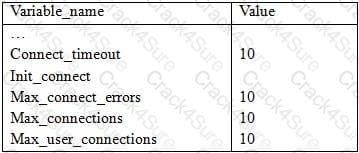A general purpose MySQL instance is configured with the following options:
-- log-slow-queries
-- long-query-time=,0001
-- log-slow-admin-queries
-- general-log
-- log-bin
-- binlog-format=STATEMENT
-- innodb-flush-log-at-trx-commit=1
Which three statements are true?
Which hardware storage option, when set up with redundant disks, offers the least stability, availability, and reliability for Mysql data?
Full Atomicity, Consistency, Isolation, Durability (ACID) compliance is a necessity for a new application, which heavily reads and writes data.
This requires the following config file options:
Sync_binlog=1
Innodb_flush_log_at_trx_commit=1
Innodb_doublewrite=1
However, this configuration is expected to introduce disk I/O overhead.
What three changes will reduce disk I/O overheads?
Which MySQL utility program should you to process and sort the slow Query log based on query time or average query time?
Consider the following statement on a RANGE partitioned table:
ALTER TABLE orders DROP PARTITION p1, p3;
What is the outcome of executing the above statement?
The following commands are available in the Linux binary distributions of Mysql:
What is the correct description of each of these commands?
An employee cannot access the company database. You check the connection variables:
Mysql> SHOW GLOBAL VARIABLES LIKE ‘%connect%’;

8 rows in set (0.00 sec)
A look at the user privileges shows:
GRANT… TO ‘bob’@’%, example.com’ WITH MAX_USER_CONNECTIONS 0;
GRANT… TO ‘key’@’%, example.com’ WITH MAX_USER_CONNECTIONS 1;
GRANT… TO ‘joe’@’%, example.com’ WITH MAX_USER_CONNECTIONS 50;
What is a valid explanation for why one of the users is unable to connect to the database?
Which statement is true about using Microsoft Windows Cluster as a platform for Mysql?